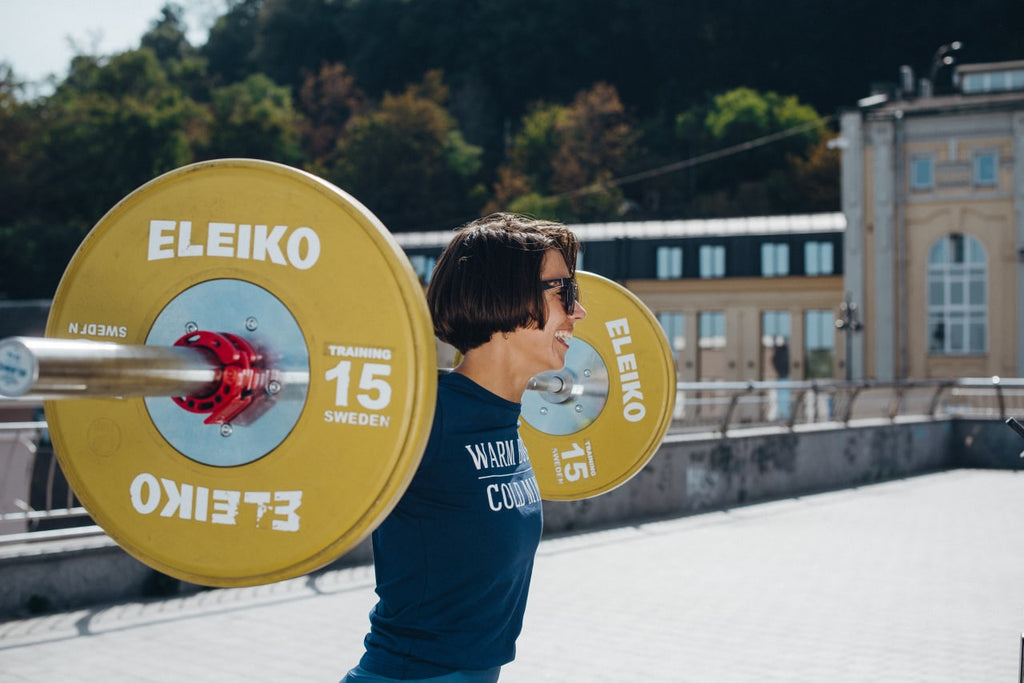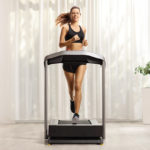Is it normal for a woman to lift weights? Many people still believe it’s weird and dangerous. This article will provide you with good arguments as to why it’s 100% natural, safe, and beneficial. Let’s take a look at the benefits of Olympic weightlifting.
Benefits of Strength Training for Women
It’s possible that you have heard that Olympic Weightlifting is harmful or that it can turn muscles into fat. All of this is false. Weightlifting has many benefits that can help you become stronger, healthier and leaner.
Weightlifting is a sport of Olympic type that involves lifting the bar overhead. Weight classes for women range from 45 kg up to 89+kg. The winning weight is determined by the total kilograms lifted during two exercises: the snatch, and the clean &jerk. Each exercise is limited to three attempts and athletes have one minute for each.
Weightlifting is not just about winning medals, competing in competitions or achieving victories. Many girls lift weights for health reasons and to enjoy themselves. Let’s find out why women lift weights.
What are the benefits of weight training for women?
Strengthens You
You become stronger when you lift weights in Olympic competitions. It is much easier to do routine tasks, such as chasing your children or carrying heavy groceries, when you are stronger. The preservation of lean muscle mass can also benefit endurance athletes, as it improves their performance in sports requiring quickness, power, and strength.
Utilizes calories effectively.
Weight training increases your metabolism in two ways. Gaining muscle increases your metabolism. You may burn more calories at rest if you have a higher metabolism than fat. It is important to know that your metabolism will increase up to two days after a weight-training session. Even after a heavy lifting workout, your body will continue to burn calories for several hours or even days. It can help reduce abdominal fat, making you appear thinner.
Visceral abdominal fat is associated with a higher risk of chronic disease, including heart and liver diseases, type 2 diabetes, and certain types cancer. Several studies have shown the benefits of strength training in females who want to lose fat. You will become thinner as you build more muscle and lose fat. It’s because muscles take up less space on the body. Even if you weigh the same on the scale, your waistline may shrink a few inches.
Reducing the risk of injury
Exercises that include Olympic weightlifting can reduce injury risk. C&J and Snatch exercise increases muscle strength, flexibility, and ROM. You can protect yourself from injury by strengthening the muscles around the ankle, hip and knee joints. Weightlifting is also a great way to correct muscle imbalances. Lifting heavy objects, for example, will cause less lower-back pain if you have a stronger core, glutes and hamstrings.
Improves heart health by managing blood sugar levels
Numerous studies have shown that weightlifting helps to improve circulation by strengthening blood vessels, lowering bad and total cholesterol as well as blood pressure. Weightlifting can help you maintain a healthy body weight and control your blood sugar. Skeletal muscles increase insulin sensitivity. It also lowers blood sugar by directing glucose into muscles rather than the blood.
Brain health is improved
Strength training may protect against age-related cognitive decline and improve brain health. Many studies on older people have shown that strength training improves cognitive performance, such as memory, processing speeds and executive functions.
Strengthen your bones
Strength training is important for bones. Exercises like pulls and Squats stress your bones temporarily and strengthen them by telling your bone-building cells to start working. Strong bones can reduce your risk of osteoporosis, fractures and accidents, especially as you age.
Self-esteem and mood are boosted
Weightlifting competitions can boost confidence. It is beneficial to overcome obstacles, strive for a goal, and appreciate the power of your own body. It can also boost your confidence, as well as self-efficacy. Self-efficacy refers to the belief that you are capable of doing a particular job. Weightlifting can also improve mood and mental health.
Weightlifting is great for women!
Myths about female weightlifting
Lifting weights is not just for men. Weightlifting can make women fat or increase their risk of injury. This is a myth. The question “Is Olympic Weightlifting completely safe for girls?” is often asked. This question is answered by saying that a well-designed exercise program is safe.
Many people still believe that women should not lift weights.
Too Many Muscles
The most common question girls ask in Olympic weightlifting is “Will I get bulky or gigantic if I lift?” The direct and short answer is “no”. You will notice a woman who has an extremely low body fat percent and is strong. She has worked hard to achieve this. Remember that this doesn’t happen quickly or randomly. You can lose weight by eating and exercising properly.
Massive weights for all exercises
Girls who are new to weightlifting may feel intimidated by elite female athletes lifting enormous weights. They might even think they have to throw themselves under the weight. If the female is new at steel sports, all of her “weightlifting’ should be similar to practicing fundamental movements with a plastic tube. The bar will eventually be empty and, as you build strength, you may be able lift a barbell similar to your body weight. It’s important to move more, improve coordination and build your muscles.
Lower back injuries
Weightlifting is not dangerous to the back. Weightlifting exercises are performed using a technique which distributes weight evenly to avoid overloading the spinal column while still making use of the leg and back muscles. Weight lifting exercises must also strengthen the stabilizing muscles in the torso. Ladies can lift weights with no physiological problems. Women are naturally more flexible than men, so they can exercise more effectively and efficiently.
Inadequate aggression
You should not worry that weightlifting will turn women into aggressive people. Sporting activities can develop “competition traits”. In general, people who are able to maintain composure and focus in stressful situations tend to be those who have participated in sports. Weight training improves your lifestyle and teaches you how to handle stress positively. You should now agree that weight training is a great benefit for women. This is the main reason women visit the gym.
Infertility and its pathology
Weightlifting will not make a female infertile. Exercise has no effect on a woman’s ability to have a regular menstrual cycle, or give birth. Smart weight distribution, along with good nutrition and rest are the most important factors. Women who are physically active have a higher chance of having a healthy pregnancy and a high birth rate.
How can a woman improve her lifting of weights?
This block will cover aspects and methods to help both beginner girls and athletes at PRO level make qualitative progress.
Menstrual cycles: Know the features
The menstrual period lasts between 21-35days and is divided into 5 phases: premenstrual (3 to 5 days), menstrual (3 to 5 days), postmenstrual (7-9 days), ovulatory (2 to 3 days), postovulatory (7-9 days) and menstrual (3 to 5 days).
During these phases, women’s performance is affected significantly. This must be considered when planning a training program for beginners as well as professional athletes.
It is important to reduce the load on the abdominal muscles and the legs, especially during the ovulatory phase, as the performance is at its lowest. It is also not recommended that you learn new techniques due to low concentration. Exercises with a light load or working out certain phases of movement with a light or medium weight are acceptable.
On the 16-25th of the cycle, the best performance can be observed 5-11 days after the end of menstruation. The second part of the cycle offers the best opportunity for flexibility and strength development. Strength training should be reduced during menstruation.
Many studies have shown that professional athletes do not experience a significant change in their capacity to work as a result of long-term adaption. It is therefore up to the individual to decide if they want to complete their training in full mode or reduce it.
Strengthen your arms with these exercises
The muscles in the upper body, core and legs of female athletes are weaker than those of men. Their maximum strength is between 39-70% less and their max leg strength is just 28% lower. Untrained men and women have the same ratio of fast to slow fibers, but the average length of the fibers is shorter in women. In the preparation period for the girls’ training program, it is recommended that the volume of pressing variations (military, sitting, and push presses) as well as bodyweight exercise (push-ups and pull-ups), be increased to strengthen upper body muscles, as well as their stabilizing muscles. The new FEMALE 2.0 program takes into consideration this aspect of increasing loads. Learn more – HERE.
Use peculiarities in the neural system
Women’s nervous systems are more excitable than men’s. Women are able to lift 90% of the weight for C&J and Snatch exercises almost every day, something that men cannot do. This allows girls to train harder and progress faster. We must also consider the recovery and load variability to avoid injury.
Consider fatigue resilience
Females have larger type-1 fibers. This makes it easier for women to withstand metabolic stress than men. It implies that women are more consistent and perform better because they are less fatigued. This implies that women are able to rest between sets for shorter periods of time. Women can perform the snatch as a triple and then rest for one minute. They can then perform a second double, rest again for another minute, perform a third single, and finally rest for 90 seconds before doing it all again. It also implies that women can handle switching weights and technical work better than men.
Be aware of the hormonal physiology
The higher estrogen levels in women allow them to handle more volume of training and respond better to slower-paced work. This hormone is essential for maintaining protein synthesis, and growing lean muscle mass. The higher estrogen levels in women also make muscle regeneration more effective, preventing the breakdown of protein during lifting. Women will respond better to eccentrics that are slower in squats, pulls, snatching and cleans. Women will benefit from exercises that include pauses in different places, such as the knee, mid-shin, etc. Slower tempos result in better movement for women.
With the new Olympic Weight Lifting Program For Women – FEMALE2.0, you can find a good training solution.
Check out the details of the program:
12 weeks plus 2 extra weeks
5 days per week
5-120 minutes per session;
50+ Specific Exercises
Focus on Olympic Lifts
All training materials are available.
The FAQ
How often should women lift weights?
The athlete’s goals and level will determine the amount of time they spend lifting weights. For recreational weightlifting, or “fun mode”, 3 days per week will suffice. However, your routine should include mobility and cardio as well. The total number of sessions per week for advanced and professional Olympic weightlifting athletes can range from 5-9.
What changes does weight-training make to a woman’s body?
Women should consider weight lifting because of the many benefits. These include stronger bones and muscles, faster metabolism, and reduced stress. Remember to start slowly and work out under the guidance of a coach.
Can weightlifting interfere with the menstrual cycle or not?
The majority of scientific research has shown that Olympic weightlifting does not affect menstruation if the loads are designed with training periodization and recuperation in mind. Nutrition and routine are also important in supporting the overall well-being of women.
The conclusion of the article is:
Athletes and coaches should pay attention to the unique features of women’s physiology, especially as more women are participating in Olympic weightlifting. We want to know what you think about the benefits of strength training for women. Please share your thoughts in the comments.
You may be interested in:
Core and Back Workout Program
Overhead mobility program
Masters Olympic Weightlifting Program
Weightlifting 8-week program
Bodybuilding Lifting Program
power clean emom











